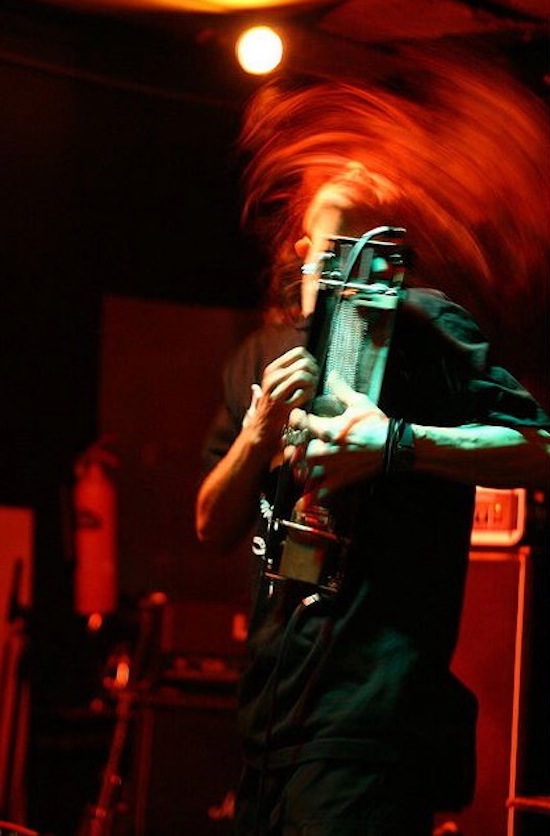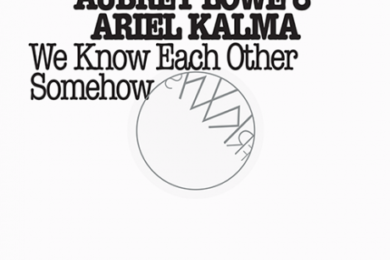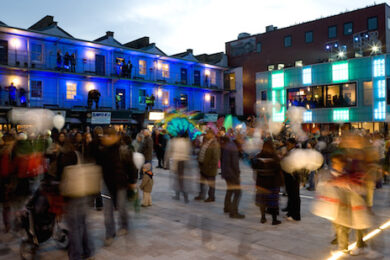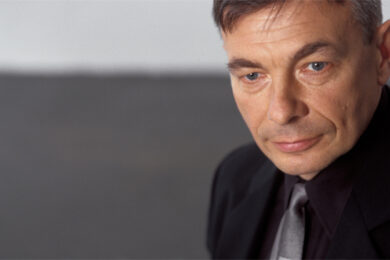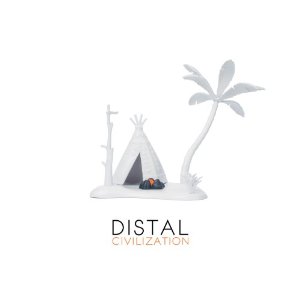"Musical sound is too limited in its qualitative variety of tones… This limited circle of pure sounds must be broken, and the infinite variety of ‘noise-sound’ conquered."
Luigi Russolo, Futurist, The Art Of Noises, 1916
The art of noise displayed by the inspired pairing of the UK’s Russell Haswell and Japan’s Pain Jerk at 2014’s London Contemporary Music Festival was one of last year’s most magical moments in performance. While the sense of occasion was encouraged by a last-minute change of venue (to overcome volume restrictions), with the audience dispatched in coaches, it was the unique sounds and nothing else which truly got my synapses firing. A freefall through constellations of mercurial audio matter was conjured up by Haswell and Pain Jerk’s Kohei Gomi, both hunched over their equipment, wide-eyed and hyper-alert, existing within the brain-melting moment.
Their seemingly unlimited sound art, both solo and in collaboration, affords a freedom to those listeners who submit to its charms without wrestling with reason, but it still manages to impart a rare sense of craftsmanship, where the chaos is deftly sculpted to provoke a strange (but far from unpleasant) oxymoronic set of sensations, where form is never compromised by function and vice versa.
This month sees the pair on their first European tour together – and what better way to start the new year than by allowing their freeform flow of phenomenal vibrations to recalibrate our minds, to brush away the cobwebs left behind by the season of consumption and get nourished by their bracing and refreshing freedom in sound.
Kohei, even though you have been releasing soundworks since the early ’90s, I understand you didn’t tour until 2007 (with Lasse Marhaug). Has the more recent experiences of touring affected the way you approach your work?
Kohei Gomi: I just had not had any chance to tour in the past and I’ve not had any support or publicity either. My first live performance overseas was the No Fun Fest in New York, in May 2007. Things are always changing, and my approach is also changing all the time. I like to betray people’s expectations sometimes. Home recording and live performance are different. I’d like to tour even more. It will always be fresh while I am doing tours regularly.
Conversely, Russell, you started out by touring regularly and your early releases were often recordings from those shows. Has doing more studio-based compositions recently affected your live work?
Russell Haswell: I’ve never toured regularly, apart from two tours with Autechre [in 2001 and 2010]. The only difference between my live and studio recordings is that I’ve a little more equipment available when I’m not travelling. And in the studio I’m lacking a heckling audience!
I understand you never edit the live recordings you release – to what degree are ‘edits’ a part of your studio-based compositions?
RH: Never say never! Editing is a post-production process, and I’ve always been interested in this role-reversal idea, using post-production tools as audio sources and composition tools. I like using editing in that way, like a film editor, similar to musique concrète or Latin freestyle editing. [I use] obvious and un-obvious edits, different wipes and crossfade directions and curves. Having said that, I rarely use crossfades and layers, and prefer traditional two-channel playlist-style editing. My edit for the CD with Pain Jerk was intended to be filmic in its duration, but I had to conform with the CD length limitation of 74-80 min.
To what extent do you both regard recorded projects and live shows as separate processes, with the former having more control, perhaps?
KG: It is impossible to control everything. I play a lot of different venues, and the sound is always different. There is always a difference in sound systems and also different output characteristics of the frequencies at each venue. I also leave room on my computer that cannot be predicted. Basically we have no rules as to our formation.
RH: The audience is the only difference. I’d like to do a classic studio album set-up, with an invited audience, like Heathen Earth or a Bette Midler album.
That’s a great idea! Who would you invite?
RH: [LAUGHS] Depending on studio size, how many people we could get in and if we’re counting ‘dead or alive’ for this hypothetical question then I guess loads of good friends and a scattering of dream friends. It’s too long a list to even begin to assemble!
Kohei, when you say that you "leave room" on your computer "that cannot be predicted" is that by randomising some aspects of what you do?
KG: For example, so that it does not know what kind of sound comes next when I drag the computer’s mouse. I also change waveforms in real time. I use a randomise function in a few cases, but it cannot escape from its algorithm. ‘Human error’ is one of the interesting factors to achieve a different, unpredicted result. I never learn special computer languages and usually I don’t read the software manual so most of my work is intuitive. It is not a mathematical approach, using such things as function and variable and random numbers. I use some plug-in synths, which can be very convenient. I also work by assembling sound from sine waves, square waves etc. I can also make completely different sounds by transforming various waveforms or processing readymade sounds.
What have you got planned for the tour? Do you rehearse or is it purely improvised? What other dates are you doing?
RH: Telepathy and mind control are some of our methods. Influences from the free-improv scenes and history are also present, of course. Our first gig is in Berlin at NK Projekt, supported by Rashad Becker, then Oslo for the All Ears festival where the Incapacitants also perform, then to Cave 12 in Geneva, and then to London for the Hackney Oslo show, where Lucy Railton will perform Xenakis: Nomos Alpha for solo cello. Kohei and myself might play solo sets and then together. We finish the tour in Nottingham at a Harbinger/Rammel/Chameleon show, where I’ve no idea who the local support is. Fingers crossed the Sleaford Mods are free…
KG: No rehearsals. It’s all about feeling. We will be different each time. But to me, it is not completely improvised. I cannot explain about our artistic domain because it exists in an illogical area.
Russell, you mentioned Harbinger Sound. You both seem to have an affinity with this label – how did you both become aware of it?
RH: Back in 1997, in Vienna, Mego records had one of the first internet mail-order shops, M.DOS. I was there for some gig and while checking the stock I noticed a Pain Jerk LP had come in, and it happened to be the very first release on Harbinger Sound.
KG: Harbinger Sound is run by Steve [Underwood] in Nottingham – he works with his own DIY attitude. I’ve met him in Tokyo, NYC, Stockholm and the UK, and we even went to France and Antwerp together.
Do you imagine how an audience will react when you’re recording and playing out? If so, what are you aiming for?
RH: Polarisation.
KG: There is only one thing that I can say to the audience: I want you to feel free, whether dancing or sitting. You should not think of it as difficult or requiring a theory. Please open your essence of sensibility as much as possible. Intelligence or knowledge will kill your essence of sensibility if you cannot keep a neutral position, and you should know that intelligence is kind of a disease sometimes.
Human beings have been unconsciously self-controlled. [They] imposed a limit upon themselves that is unconscious. Usually, humans suppress the potential ability they have originally. It is a mechanism to not destroy themselves. However, you do not feel much pain when adrenaline is secreted through the brain. That is the reason why the sound must be loud. It is a kind of perceptual training. Electroacoustic sound still has very high potential as the language that connects directly to the brain.
I find this a fascinating area. I often wonder whether the kind of music you both make brings psychological benefits by giving our brains a rest from constantly anticipating and recognising patterns (such as riffs, melodies and regular rhythms).
RH: For me it feels natural to pursue exploration and experimentation in psycho-acoustics – just as it is to sequence drums via chaotic oscillators. The results can be therapeutic and physically and mentally rewarding. It’s brain floss!
KG: An audience comes to the venue, and artists do performances, they themselves are the pattern. After all, we only exist in the name of the pattern of the music industry.

Russell, you have described before how ‘Japanese noise’ has influenced your work, and, Kohei, you have said that you do not think you make ‘noise’. What are your thoughts on ‘Japanese noise’ these days?
RH: If Incapacitants are ‘Japanese noise’ then it’s kicking. I can’t wait to see Incapacitants at All Ears, it’s going to be a rare and unmissable event! I don’t know about the current scene though. Genres are shit.
KG: ‘Japanese noise’ or ‘Japanoise’ is a most ridiculous term these days. In the early days, there was more of a pure freedom and energy. People tend to stay within the term that has been categorised, like harsh noise or power electronics or post-industrial or techno or death metal or whatever. I never intended to be a part of a specific scene. I am not playing categorised noise. To me, noise is the result of a synthesis of various signals, not categories. My point of view doesn’t exist in a stereotyped noise scene. I’m not against them, but it is a big mistake to all talk with the same point of view. I cannot talk about noise in the narrowest sense of the word.
The history of mankind has been in coexistence with all types of noise. Mankind evolved to learn a lot of things from the noise of nature, and then they made some noises for communication, like primitive rhythms or primitive screams for example. Listening to music (or trying to hear various sounds) is the same as listening to the noise. Noise is present everywhere, we cannot escape from it, and it does not only mean the noise made from a couple of hard chained distortion pedals or howling which people have categorised as such. My basic sounds are made using a variety of waveforms. It is the same even from the era when I was using analog equipment to now where I am using mainly a laptop. Nothing is forbidden, there are no rules.
Russell has been using various noises – he covers all of the gaps and it’s really more interesting than Japanese noise. He has a totally great sense of balance. I feel very much more sympathy with him than with Japanese noise. Russell understands the essence of instinct of various sounds (brutality, humour, cycle, characters, etc). I gave him an oscillator box which was made in Japan as a gift. He has mastered it more skilfully than Japanese users. The builder who made it was impressed by it, in fact.
How did you meet? What is it about each other’s work that you particularly admire? What are your similarities and differences?
KG: The first time we met was in 1996 at 2000V Tokyo when I played there. We kept in contact after that and did a performance together in Nottingham in 2012. I particularly admire how Russell is not biased. He looks at the various contexts in his wide range. About differences, we came from different contexts: Russell came from a conceptual art field and I came from the street and am an outsider really. But we are both brutal and hardcore sometimes. To me, I just do it brutal on the stage or become vacant off stage.
RH: We’re both progressively disruptive, scorpions, though Kohei chooses a harder cigarette to me!
Kohei, I’m interested in your concept of ‘post-music’. What is it and how does it relate to music?
KG: I think music has already been encoded. Lots of it is recycled stuff and variations, even in the field of experimental music. So what I’m doing is rearranging various pieces of encoded symbols. I felt that music was already saturated when it became possible to recreate music by sampling from various records easily and DJs started to create it on turntables. In other words, all sound material is able to be connected easily. All of my past works are various small pieces and they are really a small part, fragments, of a big picture or a big collage. Pain Jerk is a kind of assemblage, kind of a period in which completed form does not exist. Assemblage is not a complete form and it’s not like a composed music form, so I will use any method if the result is interesting, if it bridges great gaps and the result goes towards the more super surreal and abstract.
I think that lots of artists never risk anything… I’m not afraid of it. Lots people started to say "laptop artists are boring" and I noticed that they don’t really listen to music without listening to music with a visual [aspect]. So I didn’t hesitate to switch to use mainly a laptop. It is a confrontational perspective because with analog equipment it is very easy to see how a sound process goes, but my basic concept is nothing changes. The human brain has amazing dynamics and a massive amount of information can be sent directly to the brain. It gives different impressions to each person. It’s a really abstract thing, but it is important that there is room for people to be free, to feel and have their own impression. I want to bypass people’s preconceived ideas and prejudice. This sound which is extremely encoded and symbolised, I call it post-music. There is no prohibition. Preconceptions of what it should be are not necessary. There are always rhythms or cycles in any music. Post-music goes beyond the language barrier easily and it can change your life in a revolutionary way. Maybe I am a bit crazy…
No, I don’t think so at all. This goes back to my ‘pattern’ question earlier – do you think the psychologies involved in listening may influence the way you and other composers work in the future?
KG: It is a complete waste to try to understand everything as a theory. You do not have to think like that. All patterns are in a kind of entropy. I am not talking about it as psychological, even if it is closer to this area, and I am not a psychologist or a musicologist. As I said, it cannot explain an artistic domain which exists in a completely illogical area. The question feels similar to whether listening to satanic heavy metal may influence teenagers. We must also accept absurd and illogical matters. Also the ideal and reality are inconsistent. And I have the challenge not to ruin my own patterns with any other things – it is really difficult to actually deviate from routine. [We should] tell bad jokes, play pranks and shake the morals of the audience. Nathan Barley! I was liked at art school but a teacher rejected me when I drew a picture that he could not comprehend. He was afraid of me because it was completely outside of his theory. I’d like to create a lot of interpretations, like multi-angle polarisations.
The title of your recent album, Electroacoustic Sludge Dither Transformation Smear Grind Decomposition nO!se File Exchange Mega Edit, alludes to a range of styles, and the one that makes the most literal sense to me is electroacoustic. Russell, you’ve done a lot of work using compositional methods invented by the electroacoustic composer Iannis Xenakis, and I wondered if you both feel that your work is part of a continuum with the largely European, institutional experiments of GRM and Ircam in the late ’40s and early ’50s?
KG: I finished [the album] mainly using musique concrète methods. It was the kind of work that put the exchanged material through a microscope sometimes. And, exactly, Russell connects to Xenakis, and definitely Xenakis is top but don’t forget other important stuff on labels like INA-GRM, Wergo, Phillips, Nonesuch, Grammophon, Lovely Music. I got an offer to contribute to the Xenakis – Persepolis + Remixes CD in 2000; it sounded like a really fantastic project but then I got the original source material for ‘Persepolis’ and listened to it a lot. I thought that Xenakis was already perfect (although I prefer his Electro-Acoustic Music LP from Nonesuch to ‘Persepolis’) and thought that there is no need to process it myself. This is my top respect, and so I decided not to contribute to it.
RH: Xenakis only lasted two years at GRM, before aesthetic disagreements caused him to resign. In the end he had to start his own avant-garde computer music studio (CEMAMu, later CCMIX). Sure there is some kind of continuum but ‘Electroacoustic Sludge Dither is an experiment in method and genre collision. Funnily enough I was at Ircam the other week. Artists have to travel far and wide to situate themselves in positions for patronage. I also refused to contribute to the Xenakis remix CD from 2000!
Russell, what were you up to at Ircam? Have you used the studios at GRM or Sweden’s EMS too? Anywhere else you’d like to get your hands on?
RH: Visiting studios is a perversion for anyone working with sound or making records. Some studios have lots of gear, some hardly any, and then it’s the analog or digital question. Computer or synth. Ircam, GRM (though they have a old analog synth), even CCMIX are, or were, more or less computer-based, so it’s more of a software thing and visiting these places isn’t always necessary. EMS in Stockholm has large Buchla and Serge modular synth systems (where I hope to work this year with Lucy Railton), so in the end I took some of my modular synths to Ircam to record additional material for a project they were producing. And while I was there took some time to visit the anechoic chamber and listen to my body for a while.
What was the compositional process for Electroacoustic Sludge Dither? There seems to be a few clues in the title…
RH: Time Distortion. Audio materials were exchanged and worked on in Tokyo and Suffolk via the internet and then edited, applying many different and contrasting techniques.
KG: It was an effort not to hold on to the original sound sources as much as possible. I was chopping more finely as the material was exchanged.
Russell, 2014 seemed to be an amazing year for you. Not only were you releasing more records and playing more shows, but you were also courted by more ‘established’ channels, perhaps, such as BBC Radio 3, where you collaborated with Lucy Railton, Aldeburgh Music, where you worked with the vocal ensemble Exaudi, and the London Contemporary Music Festival. What’s been the catalyst for this increase in activity?
RH: A number of things that started a few years ago. Using the computer only as a recording and classic two-channel editing device, and not as a sound generator. Going modular, getting a Peli case, keeping an open mind, accepting offers and invitations that maybe I wouldn’t have in the past. Making and releasing more records.
What releases have you got planned for the future, solo or otherwise?
KG: I’m just doing my own archive work. It is taking so much time because there is a bunch of recorded material. I can’t reveal any details of it yet. Then hopefully I’ll release a new album if a good label is interested.
RH: I have albums almost finished or complete for Bocian, Diagonal and Editions Mego.
Any idea when they’re due out? Does each have any distinct concept or process?
RH: Later this year. I’m trying to wrap them all up at the moment, but as always, it’s taking time, and the labels have their schedules… blah! I’ve just finalised sequencing and titling the Bocian LP, called Constitutional. With the Diagonal LP, I’m 90% of the way there. I’m missing a track and have to sequence the running order. With the Editions Mego album I’m waiting for an accompanying track which is something more composed, combining church bells and bat recordings and chaotic black metal drumming, noise and feedback, but [otherwise] that’s been finished more than a year.
Russell Haswell and Pain Jerk tour Europe this month, playing at London’s Oslo on January 13th. Tickets are available here. Haswell also plays as part of Consumer Electronics on Wednesday 14th

